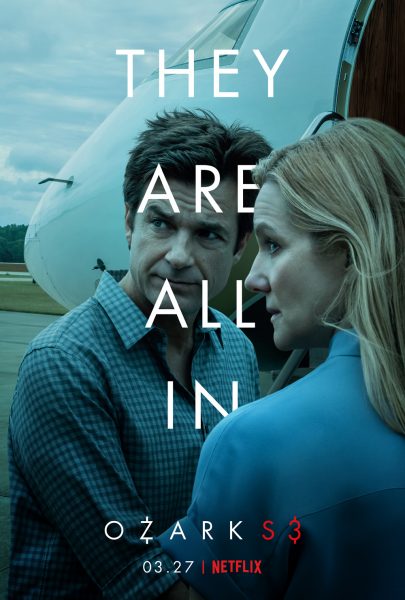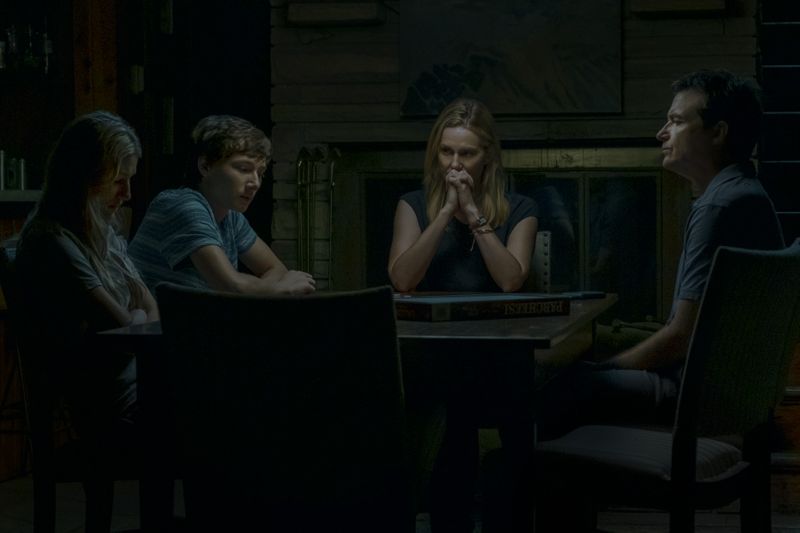
The hour-long crime drama.
It’s a genre of television as timeless as chocolate cake—there are countless amounts of them made every year, but when you get a taste of a truly spectacular one? There’s nothing more delicious.
The third season of Ozark, Netflix’s tentpole series starring Jason Bateman and Laura Linney, is a perfect example of this. It’s not another Betty Crocker—this, my friends, is a masterpiece worthy of a Michelin star chef.
Ozark’s first season premiered on the juggernaut streaming service in 2017 and is an increasingly rare instance in “Peak TV” where every season has been better than the previous. Not only has its viewership and industry prestige increased with each installment, but so has its critical acclaim. Season 1 clocked in at a 70% on Rotten Tomatoes with 5 total Emmy nominations, while Season 2 arrived with a 76% and 9 total Emmy nominations (including Best Drama series) and won two: Outstanding Supporting Actress in a Drama Series and Outstanding Directing for a Drama Series.
Season 3? A 97%, with a slew of Emmy nominations and wins across the board just an inevitability.
With that in mind, what makes the third chapter of Ozark such a smashing success? How does it expand and improve upon the already well-regarded two previous iterations?
While there are a million avenues one could go down in dissecting that question, this article will focus on three: the importance of casting, implementing cliff-hanging endings fraught with rising tension and stakes, and possessing a wholly distinctive visual DNA or “look.”
Throughout the run of Ozark, one of its defining characteristics have been its performances. Jason Bateman’s career-altering turn as Marty Byrde, a money launderer in over his head; Julia Garner’s lightning-in-a-bottle portrayal of Ruth Langmore, a firebrand Southern criminal turned associate of Marty’s; and Lisa Emery’s chilling role as Darlene Snell, a sociopathic heroin dealer are consistently noted standouts.
Season 3 is no different. All the “usual suspects” are there—and then some. This season’s cast of characters, though, is defined by two massive roles—Laura Linney’s Wendy Byrde, and Tom Pelphrey’s Ben Davis.
Obviously, Laura Linney has been a part of the series from the beginning—a mainstay since its inception. But, with each season, Wendy’s role has grown exponentially as the writers give her more influence in driving the story engine of Ozark. And in this season, it’s just as much Wendy’s show as it is Marty’s. Her increased presence in the series—shown through arcs such as her attempt to expand Byrde Enterprises into more legitimate, legal channels and her contentious couples counseling sessions with Marty as they try to repair their fractured relationship—is a bolt of electricity for the season. Her intensified story and growth greatly expands the show’s scope both thematically and plot-wise. Laura’s performance as Wendy is thunderous, a prime example of how to produce a strong, badass, female antihero who stands on her own two feet. And in this day and age? We need that now more than ever.
In addition to the magnification of Wendy, Ozark season 3 is also enhanced by the introduction of a brand new figure: Ben Davis, Wendy’s bipolar, estranged brother. In every season of Ozark, there has been a “wild card,” a Joker-like figure whose unpredictable behavior acts as a wedge tampering with the well-oiled machinery that is Byrde Enterprises. In season 1, it was Del. Season 2, it was the Snells. And in Season 3? That honor goes to Ben.
Brilliantly played by Tom Pelphrey, Ben is a ticking time bomb of a human, someone who serves as a pressure cooker for the Byrde family and increasingly threatens their dynamic and safety. Due to the fragile state of his mental health, Ben poses the risk of blowing the Byrde operation at any given point, putting Marty, Wendy, Jonah, and Charlotte in the crosshairs of both their Navarro drug cartel overlords and the increasingly strong FBI investigation into the riverboat casino. In the wrong hands, Ben could have potentially come across as one-note or too heavy-handed, but Tom threads the needle with expert precision, crafting a fully dimensional character who spawns an enormous ripple effect on the holistic trajectory of the show.

Steve Deitl / Netflix
Ozark has often been compared to Breaking Bad for its overall story structure—a “normal” everyman going bad and descending deeper and deeper into moral bankruptcy and criminality. And while that’s certainly true, it is not the only thing that Ozark has in common with Breaking Bad. Like Breaking Bad, Ozark absolutely excels in crafting cliffhanger episode endings. Moreover, Ozark practically ends every single episode with some shocking conclusion that leaves only one possible audience response: unhinge your jaw from the floor and press the “play next episode” button on Netflix.
Employing this breakneck style of structural pacing from a writing standpoint gives Ozark an enormous leg up on its competition—it classifies the show in the “must-watch” or “bingeable” categories. In this day and age, where there are quite literally hundreds of new shows created each year, you have to do everything you can to keep audiences engaged and not give them a reason to turn off or switch to watching something else. While the first two seasons of Ozark achieved this, the third season takes it even further, relentlessly pummeling viewers with one plot twist and major character reveal after another.
Now, it should be said, there are plenty of shows that employ this strategy and don’t end up delivering the goods. Their endings fall flat, feeling not at all earned and more exploitative than organic. Ozark doesn’t do that. While there won’t be any spoilers here, every single sharp plot and character swing in season 3 is 1000% justified and…well, you’ll just have to watch to see.
Finally, we come to probably one of the most-talked about (but absolutely still worth mentioning) aspects of Ozark—its visual style. Simply put, Ozark looks like nothing else on TV. Its moody, deep blue-tinged color palette is incredibly distinctive and has inspired many works since its premiere. Everything from its cinematography down to the sound design and lighting create an unmistakable aura harkening to the work of classic film auteurs like David Fincher or David Lynch. While the first two seasons were already remarkable in this regard, they really upped the ante in season three. Under the stewardship of EP/Director Jason Bateman, part three of the Ozark saga is the best-looking it has ever been. To this reviewer, it seems as though Netflix really backed up and unloaded the money truck in the budget, as every single sequence is shot to perfection, steeped in a bleak elegance that is a glory to behold.
On the whole, Ozark’s third season solidifies the series as the best hour-long program currently on the air. At this point, it is impossible to deny that it is Netflix’s flagship product—a show that is destined to tantalize and enthrall audiences for the foreseeable future. And I, for one, couldn’t be happier.
